Achieving a Sustainable Society
Solving social issues through the products
: With the environment
Products
Eco friendly
Shin-Etsu Group Products and Technologies that Contribute to Environmental Conservation
The Shin-Etsu Group's various products are developed while considering their contributions to reducing greenhouse gas emissions, energy conservation, and resource conservation at the stage of use. These products are used in a wide range of fields such as industry, daily life, and renewable energy. We will continue to develop products that contribute to carbon neutrality.
Silicones
The Group produces over 5,000 silicone products, such as household products, automobiles,
construction, and solar cells. While being put to each of their uses, these products are
contributing to reductions in greenhouse gas emissions.
We, together with other members of the global silicone industry, carried out a study of the
entire silicone market, examining silicone greenhouse gas emissions at the phase of production
and how much greenhouse gas emissions are curbed by the use of silicone, in comparison to
silicone substitutes and alternative methods. The study found that the silicone used as a
product has the effect of reducing emissions1 by 9 times that of greenhouse gases
emitted during the manufacturing and disposal of silicones. This is equivalent to a reduction of
54 million CO2-tons of greenhouse gases2 annually.
Silicone used in automobiles, construction, and solar cells account for the greatest share of
overall silicone greenhouse gas emissions reductions. Silicone is contributing significantly to
the improvment of sustainability.
1 Greenhouse Gas Emission Reduction Effects
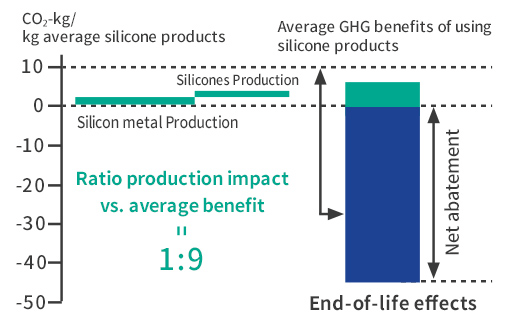
※2012 survey results
2 Examples of Greenhouse Gas
Emission Reductions
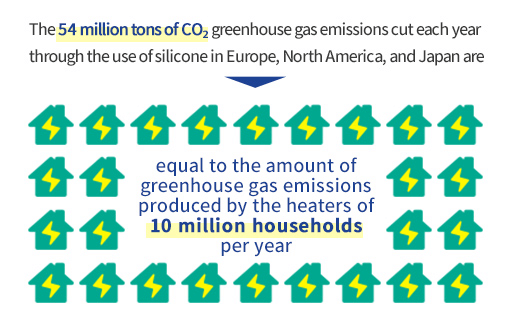
Fields in Which Silicone Use is Reducing Greenhouse Gas Emissions, and Major Silicone Uses
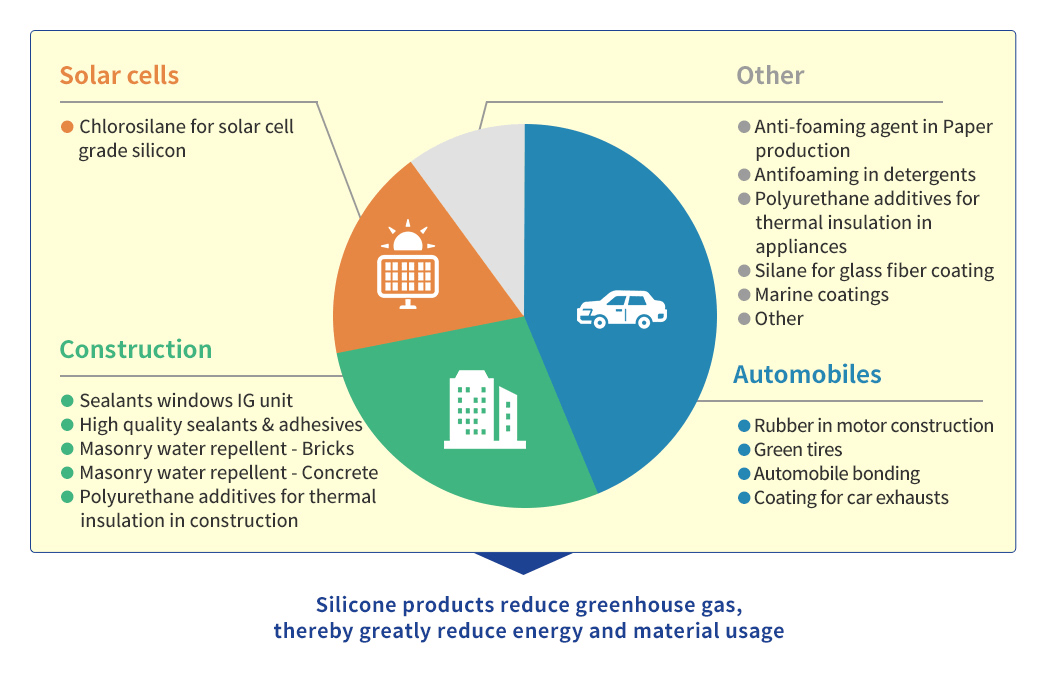
Source: Silicone Industry Association of Japan “Silicone-Chemistry Carbon Balance”
Polyvinyl chloride resin (PVC)
Approximately 60% of the raw materials used in PVC are salts, which are abundant throughout the world. Compared to other general-purpose resins, the benefits of PVC include a low dependence on petroleum resources, placing a relatively small burden on the environment. The process of manufacturing PVC from raw materials uses around 60% of the energy required to make other general-purpose resins. Highly durable and easy to recycle, PVC is used for a wide range of social infrastructure materials, including vinyl windows, water and sewerage pipes, public works and other construction. Compared to aluminum, PVC resin windows have lower thermal conductivity and are superior in insulating properties, so they are expected to protect indoors from the heat and cold of the outside air and save energy. In addition to being mainstream in Europe and the United States, it is also popular in China and Japan. According to the Vinyl Environmental Council (VEC), shipments of window frames in FY2021 reached a record high of 31,708 tons, and continued to remain at a high level of 30,654 tons in FY2022. Furthermore, according to the results of a survey released by the Japan Sash Manufacturers Association in March 2023, the ratio of resin windows in detached houses increased by 2.6% from the previous year to 28.5%. Looking at the ratio by region, 99.5% of the windows of detached houses and 95.3% of the windows of condominiums are made of resin in Hokkaido, which is a cold region. Compared to ductile cast-iron pipes1, PVC pipes have lower total carbon-dioxide emissions2 over their lifecycles, contributing to the prevention of global warming.
1Ductile cast-iron pipe
Tubes produced by spheroidal graphite cast iron, in which the precipitated graphite shape in the cast iron structure was changed from flaky to spheroidal. Has more than twice the strength and high toughness of the flaky graphite cast iron.
2Lifecycle carbon-dioxide emissions
Total carbon dioxide emissions for a product, from the gathering of raw materials, through the production, use, disposal, and recycling stages.
Source:
Japan Chemical Industry Association “Lifecycle Analysis of Chemical Products in Japan and around the World”, third edition
Vinyl Environmental Council website “Living with PVC Windows”, “PVC production and shipment results:_Breakdown by product ”
Japan Sash Manufacturers Association "March 2023: Residential building material usage survey"
Rare Earth Magnets
Rare-earth magnets are roughly 10 times as strong as conventional ferrite magnets, offering a
great deal of magnetic force despite their compact size. These properties allow them to
contribute to making motors for hybrid and electric vehicles, energy saving air conditioning
compressor motors, and the like more compact, lightweight, and high powered.
For example, using rare-earth magnets in air conditioning compressors can improve energy
efficiency by 5 to 10%. This cuts overall power usage, helping to reduce carbon-dioxide
emissions. Rare-earth magnets are also used in wind power generation motors, contributing to the
spread of renewable energy.
Better Mobility - Better means of transportation Shin-Etsu Group's products support Eco-friendly cars
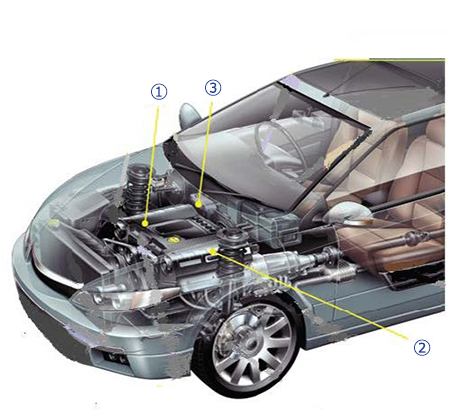
- (1) Drive motors and generators
- (Neodymium magnets)
・Smaller and lighter
・Heat-resistant
・Reduced overcurrent - (2) Starters and generators
- (Neodymium magnets)
・High-powered
・Heat-resistant - (3) Power control units
- (Silicon wafers, encapsulant materials, and thermal interface materials)
・Smaller and lighter
・High sealing performance
・Heat-dissipating properties
The Company's neodymium magnets1 are used in drive motors and generators, which are the most important core unit of eco-friendly electric vehicles (EVs) and hybrid vehicles (HVs). The Company's silicon wafers, sealing materials, and heat dissipation materials are also used in power control units for system control. Compared to gasoline cars, HVs can reduce carbon dioxide emissions by about 40%, while EVs can reduce emissions by 100%.* In addition, the location of the factory incorporates a carbon-neutral perspective. Our manufacturing bases for neodymium magnets are located in Fukui Prefecture of Japan and Vietnam, and at the plant in Fukui prefecture, more than 29% of the purchased electricity is renewable energy, and at the plant in Vietnam, 36%2 is renewable energy. Both of which far exceed the average ratio in Japan. The Company is promoting the stable supply of various products used in eco-friendly cars and the development of new products, and the shipment volume of such products is increasing year by year. The Company' products are making a significant contribution to reducing CO2 emissions.
- 1Neodymium magnet
A type of rare earth magnet with very strong magnetic force, composed mainly of neodymium, iron, and boron. It contributes to the miniaturization and reduction of energy consumption of motors and other devices with its strong magnetic force.
- 2The renewable energy ratio of the Vietnam plant is data for FY2020.
- * Source: "Contributing to Lower Emissions through the Global Value Chain" by Keidanren (Japan Business Federation)
Contributions of the Company's neodymium magnet to reducing CO2 emissions due to its use in eco-friendly car
According to the results of our calculations, the use of our neodymium magnets in eco-friendly cars reduced CO2 emissions by approximately 2.7million tons in FY2021. Assuming that cars are used for 16 years, this means that we can reduce CO2 emissions by approximately 43 million tons over the next 16 years.
As a result of global carbon neutrality policies, the percentage of eco-frienfly cars has risen rapidly, and the penetration rate of EVs worldwide is expected to reach 100% by 2050.* Demand for neodymium magnets for eco-friendly cars are expected to continue to grow. The Company will steadily respond to growing demand.
- * Source: "Energy Technology Perspective 2017" by IEA
■Future issues and challenges
・Neodymium magnets: Promote a stable supply system by expanding production facilities and recycling technologies, and improve the performance of magnets while reducing their size and weight
・Silicon wafers: Stable supply of high-quality silicon wafers that support miniaturization and other requirements
・Encapsulant materials: High sealing performance and insulation properties
・Heat dissipation materials: High heat dissipation properties
Achieving a Sustainable Society
Solving social issues through the products
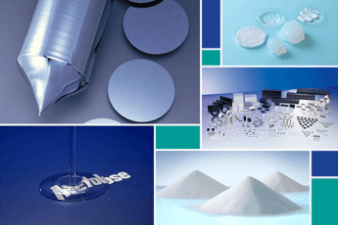
With the environment
Silicones Polyvinyl chloride resin (PVC) Rare Earth MagnetsComfortable living
Polyvinyl chloride resin (PVC) Caustic soda Silicon wafers/ Magnet Silicone Electrophysiological Dry Electrodes /High-Stretchable Wiring Materia Cellulose derivativesReduction of environmental impact in plants




